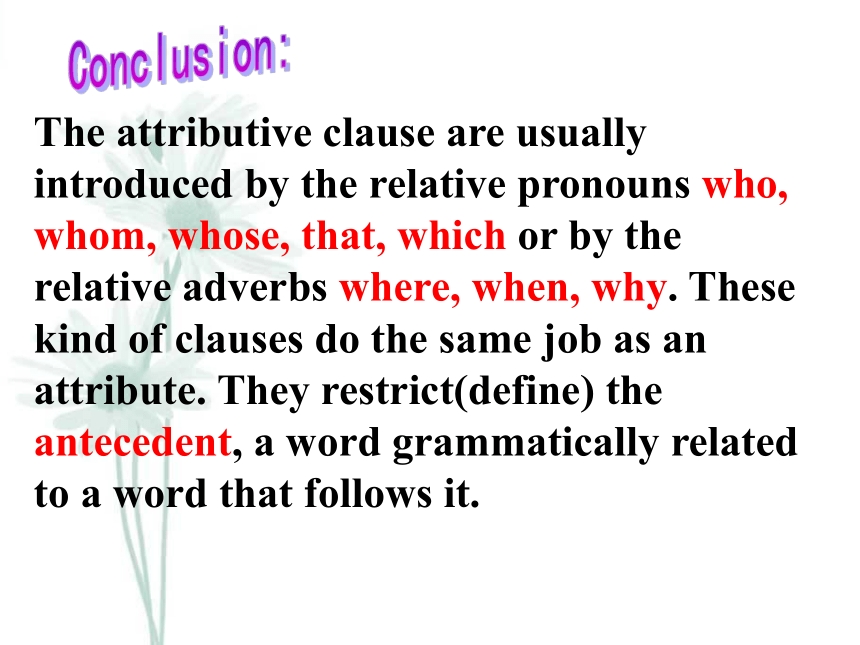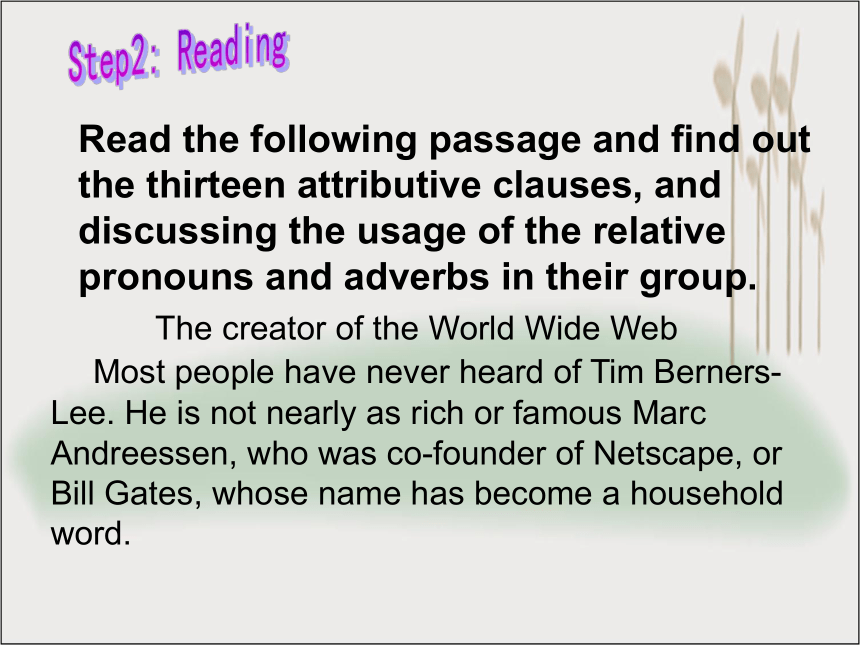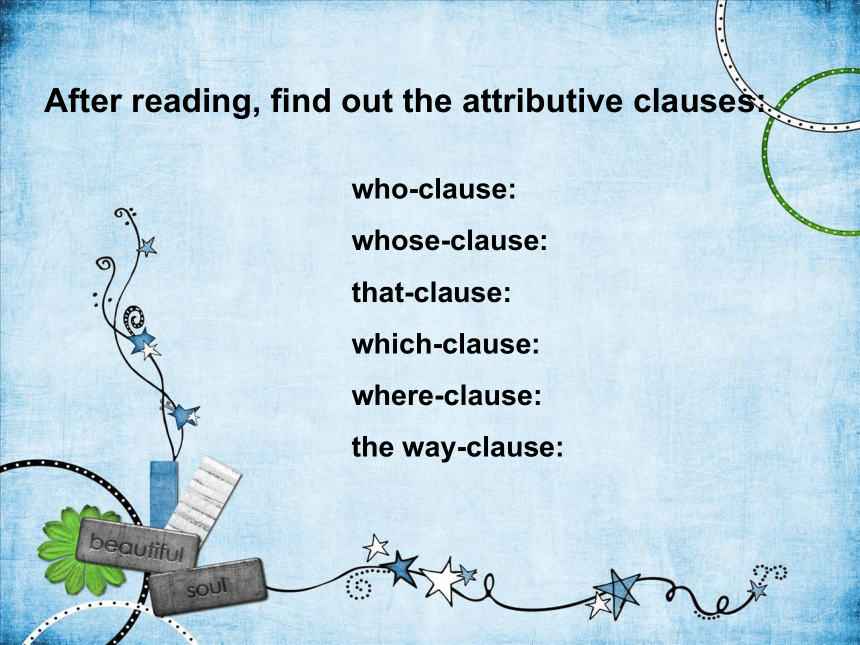Module 5 Great people and Great Invention Grammar_The Attributive Clause课件(25张PPT)
文档属性
| 名称 | Module 5 Great people and Great Invention Grammar_The Attributive Clause课件(25张PPT) |  | |
| 格式 | zip | ||
| 文件大小 | 3.6MB | ||
| 资源类型 | 教案 | ||
| 版本资源 | 外研版 | ||
| 科目 | 英语 | ||
| 更新时间 | 2019-08-21 17:02:57 | ||
图片预览









文档简介
课件25张PPT。The Attributive ClauseGrammarBook 3 Module 5That's why you go awayLet’s enjoy the music!Step1 Lead-inBaby won’t you tell me why there is sadness in your eyes
I don’t wanna say goodbye to you
Love is one big illusion I should try to forget
but there is something left in my head
You’re the one who set it up now you’re the one to make it stop
I’m the one who’s feeling lost right now
Now you want me to forget every little thing you saidbut there is something left in my head
I won’t forget the way youre kissing
The feeling’s so strong were lasting for so long
But I’m not the man your heart is missing
That’s why you go away I know
You were never satisfied no matter how I tried
Now you wanna say goodbye to me
Love is one big illusion I should try to forget
but there is something left in my head
I won’t forget the way you’re kissing
The feeling’s so strong were lasting for so long
The attributive clauses: 1. Love is one big illusion I should try to forget, but there is something left in my head2. You’re the one who set it up now you’re the one to make it stop3. I’m the one who’s feeling lost right now4. Now you want me to forget every little thing you said, but there is something left in my head5. I won’t forget the way you’re kissing 6. But I’m not the man your heart is missing The attributive clause are usually introduced by the relative pronouns who, whom, whose, that, which or by the relative adverbs where, when, why. These kind of clauses do the same job as an attribute. They restrict(define) the antecedent, a word grammatically related to a word that follows it.Conclusion:Read the following passage and find out the thirteen attributive clauses, and discussing the usage of the relative pronouns and adverbs in their group.Step2: Reading Most people have never heard of Tim Berners-Lee. He is not nearly as rich or famous Marc Andreessen, who was co-founder of Netscape, or Bill Gates, whose name has become a household word.
The creator of the World Wide Web Berners-lee, who works in a small office at the Massachusetts Institute of Technology, is the creator of the World Wide Web. The creation of the Web is so important that some people compareBerners-lee to Johann Gutenberg, who invented printing by moveable type in the fifteenth century
Berners-Lee was born in England in 1955. His parents, who helped design the world’s first commercially available computer, gave him a great love of mathematics and learning.
In 1980, Berners-Lee went to work at CERN, a physics laboratory in Geneva, Switzerland,
where he had a lot of material to learn quickly. He had a poor memory for facts and wanted to find a way to help him keep track of things he couldn’t remember. He devised a software program that allowed him to create a document that had links to other documents. He continued to develop his idea through the 1980s. he wanted to find a way to connect the knowledge and creativity of people all over the world.
In 1991, his project became known as the World Wide Web. The number of Internet users started to grow quickly. However, Berners-Lee is not completely happy with the way the Web has developed. He thinks it has become a passive tool for so many people, not the tool for creativity that he had imagined. In 1999, Berners-Lee published a book which is called Weaving the Web, in which he answers questions he is often asked: “What were you thinking when you invented the Web?” “What do you think of it now?” “Where is the Web going to take us in the future.
After reading, find out the attributive clauses:who-clause:
whose-clause:
that-clause:
which-clause:
where-clause:
the way-clause:1.He is not nearly as rich or famous Marc Andreessen, who was co-founder of Netscape
who-clause:2. Berners-lee, who works in a small office at the Massachusetts Institute of Technology, is the creator of the World Wide Web3. The creation of the Web is so important that some people compare Berners-lee to Johann Gutenberg, who invented printing by moveable type in the fifteenth century
4. His parents, who helped design the world’s first commercially available computer, gave him a great love of mathematics and learningWho always refers to persons. It is used as the subject or the object of the clause .Whom always refers to persons. It is used as the object of a verb or a preposition. It is often omitted.whom-clause:I know Peter whom I love
The girl whom you talked to is my friendwho-clause: He is not nearly as rich or famous Marc Andreessen, who was cofounder of Netscape, or Bill Gates, whose name has become a household word.whose-clause:Whose is the possessive relative pronoun. It is generally used both for animals and things, but unusual except in very formal English.He devised a software program that allowed him to create a document that had links to other documents.
that-clause:That is often used in restrictive clauses, referring to denotations both of persons and non-persons. It is used as subject and object, especially as an object, replacing which or whom.3. He had a poor memory for facts and wanted to find a way to help him keep track of things he couldn’t remember 2. He thinks it has become a passive tool for so many people, not the tool for creativity that he had imagined.In 1999, Berners-Lee published a book which is called Weaving the Web which-clause:Football is a game which is liked by most boys
This is the pen which he boughtAs a relative pronoun, which is nearly always used only for things. It occurs as either subject or object of the verb in the clause.In 1980, Berners-Lee went to work at CERN, a physics laboratory in Geneva, Switzerland, where he had a lot of material to learn quickly. where-clause:In 1999, Berners-Lee published a book which is called Weaving the Web, in which he answers questions he is often askedWhen: I’ll never forget the day when we met for the first time.
The story happened on the day when he was born.
Why: I don’t know the reason why he is always late for school
This is the reason why we must go earlier
The words where, when, and why, the relative adverbs, also introduce attributive clauses. They can be substituted for preposition plus which or whom. when and where can be used to mean at which or in which. After the word reason, why is used to mean for which and the noun before why is only reason.relative adverb:Preposition + relative pronouns= relative adverbs However, Berners-Lee is not completely happy with the way the Web has developed.
I won’t forget the way you’re kissingthe way:When the way is used as antecedent, the relative words are that, which or omission plus the sentence in which there’s no subject or object. We can also use the relative words plus the whole sentence. Step3: Shared ReadingIt is about a video of Obama's speech . There are some Attributive Clauses in this speech. While listening, students find out the clauses. After that, they can analyze the sentences and imitate the speech. 1. Our citizens, seared by the memory of those we have lost, know too well the price that is paid for liberty.2. The knowledge of their sacrifice will keep us forever vigilant against those who would do us harm.3. But we are also heirs to those who won the peace and not just the war, who turned sworn enemies into the surest of friends, and we must carry those lessons into this time as well.4. We will show the courage to try and resolve our differences with other nations peacefully – not?because we are naive about the dangers we face, but because engagement can more durably lift suspicion and fear. 6. We will support democracy from Asia to Africa; from the Americas to the Middle East, because our interests and our conscience compel us to act on behalf of those who long for freedom.7. And we must be a source of hope to the poor, the sick, the marginalized, the victims of prejudice – not out of mere charity, but because peace in our time requires the constant advance of those principles that our common creed describes: tolerance and opportunity; human dignity and justice.5. America will remain the anchor of strong alliances in every corner of the globe; and we will renew those institutions that extend our capacity to manage crisis abroad, for no one has a?greater stake in a peaceful world than its most powerful nation.
Then the students imitate the Obama's speech and share their performance.Step4 WritingThe teacher ask the students to writing something about Obama with the attributive clause. Or they can writing something about a person with the attributive clause (group work) .Show TimeStep5 Summary(Micro Course)The teacher use the micro course to make a summary. Writing a composition about a person within 100 words, using (at least 5 attributive clauses.)Step6 Assignment
I don’t wanna say goodbye to you
Love is one big illusion I should try to forget
but there is something left in my head
You’re the one who set it up now you’re the one to make it stop
I’m the one who’s feeling lost right now
Now you want me to forget every little thing you saidbut there is something left in my head
I won’t forget the way youre kissing
The feeling’s so strong were lasting for so long
But I’m not the man your heart is missing
That’s why you go away I know
You were never satisfied no matter how I tried
Now you wanna say goodbye to me
Love is one big illusion I should try to forget
but there is something left in my head
I won’t forget the way you’re kissing
The feeling’s so strong were lasting for so long
The attributive clauses: 1. Love is one big illusion I should try to forget, but there is something left in my head2. You’re the one who set it up now you’re the one to make it stop3. I’m the one who’s feeling lost right now4. Now you want me to forget every little thing you said, but there is something left in my head5. I won’t forget the way you’re kissing 6. But I’m not the man your heart is missing The attributive clause are usually introduced by the relative pronouns who, whom, whose, that, which or by the relative adverbs where, when, why. These kind of clauses do the same job as an attribute. They restrict(define) the antecedent, a word grammatically related to a word that follows it.Conclusion:Read the following passage and find out the thirteen attributive clauses, and discussing the usage of the relative pronouns and adverbs in their group.Step2: Reading Most people have never heard of Tim Berners-Lee. He is not nearly as rich or famous Marc Andreessen, who was co-founder of Netscape, or Bill Gates, whose name has become a household word.
The creator of the World Wide Web Berners-lee, who works in a small office at the Massachusetts Institute of Technology, is the creator of the World Wide Web. The creation of the Web is so important that some people compareBerners-lee to Johann Gutenberg, who invented printing by moveable type in the fifteenth century
Berners-Lee was born in England in 1955. His parents, who helped design the world’s first commercially available computer, gave him a great love of mathematics and learning.
In 1980, Berners-Lee went to work at CERN, a physics laboratory in Geneva, Switzerland,
where he had a lot of material to learn quickly. He had a poor memory for facts and wanted to find a way to help him keep track of things he couldn’t remember. He devised a software program that allowed him to create a document that had links to other documents. He continued to develop his idea through the 1980s. he wanted to find a way to connect the knowledge and creativity of people all over the world.
In 1991, his project became known as the World Wide Web. The number of Internet users started to grow quickly. However, Berners-Lee is not completely happy with the way the Web has developed. He thinks it has become a passive tool for so many people, not the tool for creativity that he had imagined. In 1999, Berners-Lee published a book which is called Weaving the Web, in which he answers questions he is often asked: “What were you thinking when you invented the Web?” “What do you think of it now?” “Where is the Web going to take us in the future.
After reading, find out the attributive clauses:who-clause:
whose-clause:
that-clause:
which-clause:
where-clause:
the way-clause:1.He is not nearly as rich or famous Marc Andreessen, who was co-founder of Netscape
who-clause:2. Berners-lee, who works in a small office at the Massachusetts Institute of Technology, is the creator of the World Wide Web3. The creation of the Web is so important that some people compare Berners-lee to Johann Gutenberg, who invented printing by moveable type in the fifteenth century
4. His parents, who helped design the world’s first commercially available computer, gave him a great love of mathematics and learningWho always refers to persons. It is used as the subject or the object of the clause .Whom always refers to persons. It is used as the object of a verb or a preposition. It is often omitted.whom-clause:I know Peter whom I love
The girl whom you talked to is my friendwho-clause: He is not nearly as rich or famous Marc Andreessen, who was cofounder of Netscape, or Bill Gates, whose name has become a household word.whose-clause:Whose is the possessive relative pronoun. It is generally used both for animals and things, but unusual except in very formal English.He devised a software program that allowed him to create a document that had links to other documents.
that-clause:That is often used in restrictive clauses, referring to denotations both of persons and non-persons. It is used as subject and object, especially as an object, replacing which or whom.3. He had a poor memory for facts and wanted to find a way to help him keep track of things he couldn’t remember 2. He thinks it has become a passive tool for so many people, not the tool for creativity that he had imagined.In 1999, Berners-Lee published a book which is called Weaving the Web which-clause:Football is a game which is liked by most boys
This is the pen which he boughtAs a relative pronoun, which is nearly always used only for things. It occurs as either subject or object of the verb in the clause.In 1980, Berners-Lee went to work at CERN, a physics laboratory in Geneva, Switzerland, where he had a lot of material to learn quickly. where-clause:In 1999, Berners-Lee published a book which is called Weaving the Web, in which he answers questions he is often askedWhen: I’ll never forget the day when we met for the first time.
The story happened on the day when he was born.
Why: I don’t know the reason why he is always late for school
This is the reason why we must go earlier
The words where, when, and why, the relative adverbs, also introduce attributive clauses. They can be substituted for preposition plus which or whom. when and where can be used to mean at which or in which. After the word reason, why is used to mean for which and the noun before why is only reason.relative adverb:Preposition + relative pronouns= relative adverbs However, Berners-Lee is not completely happy with the way the Web has developed.
I won’t forget the way you’re kissingthe way:When the way is used as antecedent, the relative words are that, which or omission plus the sentence in which there’s no subject or object. We can also use the relative words plus the whole sentence. Step3: Shared ReadingIt is about a video of Obama's speech . There are some Attributive Clauses in this speech. While listening, students find out the clauses. After that, they can analyze the sentences and imitate the speech. 1. Our citizens, seared by the memory of those we have lost, know too well the price that is paid for liberty.2. The knowledge of their sacrifice will keep us forever vigilant against those who would do us harm.3. But we are also heirs to those who won the peace and not just the war, who turned sworn enemies into the surest of friends, and we must carry those lessons into this time as well.4. We will show the courage to try and resolve our differences with other nations peacefully – not?because we are naive about the dangers we face, but because engagement can more durably lift suspicion and fear. 6. We will support democracy from Asia to Africa; from the Americas to the Middle East, because our interests and our conscience compel us to act on behalf of those who long for freedom.7. And we must be a source of hope to the poor, the sick, the marginalized, the victims of prejudice – not out of mere charity, but because peace in our time requires the constant advance of those principles that our common creed describes: tolerance and opportunity; human dignity and justice.5. America will remain the anchor of strong alliances in every corner of the globe; and we will renew those institutions that extend our capacity to manage crisis abroad, for no one has a?greater stake in a peaceful world than its most powerful nation.
Then the students imitate the Obama's speech and share their performance.Step4 WritingThe teacher ask the students to writing something about Obama with the attributive clause. Or they can writing something about a person with the attributive clause (group work) .Show TimeStep5 Summary(Micro Course)The teacher use the micro course to make a summary. Writing a composition about a person within 100 words, using (at least 5 attributive clauses.)Step6 Assignment
